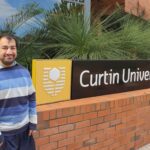Researchers at Curtin Malaysia are exploring the potential of extracts from a variety of natural produce, some indigenous to Sarawak, using a pilot-scale supercritical fluid extraction (SFE) system within its new Pilot Plant Facility.
Researchers at the state-of-the-art facility are establishing protocols for pilot-scale supercritical fluid extraction of oil and fat from both dabai (Canarium odotophyllum Miq.) and frankincense (Boswellia sacra) resin.
Dabai has significant commercial potential due to its pharmaceutical and nutraceutical properties, owing to its high antioxidant levels.

Frankincense is an aromatic resin obtained from trees of the genus Boswellia, particularly Boswellia sacra, and has been used for centuries in Middle Eastern, African and Asian folk medicine. Its increasing rarity makes it a high-value ingredient for perfumery and aromatherapy.
Frankincense oil is traditionally extracted via steam distillation, with very little known about its extraction via SFE. The facility uses high-grade frankincense resin imported from Oman as its raw material.
The SFE system, which is capable of producing pilot-scale quantities of resins, fats and oils for sale and further processing elsewhere, was designed and fabricated by NATEX Prozesstechnologie GsmH in Austria and installed at the Pilot Plant Facility in January last year.
Other plans for the SFE system at the Pilot Plant Facility include supercritical fluid extraction of oleoresins from Sarawak Black Pepper, which is world renowned for its high quality and unique flavour profile. The oleoresins will be supplied to the Malaysian Pepper Board which will be responsible for developing a market for them.
Another plant from which essential oils for perfumeries can be extracted using SME is gaharu (Aquilaria malaccensis), a plant widely found in Sarawak. Gaharu oil is one of the most expensive oils used in perfumery and there are now relatively large areas of gaharu plantations in Sarawak, including in the Baram region near Miri.
The Pilot Plant Facility is also collaborating with a small local entrepreneurship, Borneo Rainforest Vanilla Company, using SFE as an alternative to the traditional distillation method to extract gaharu oil.

What is SFE?
SFE uses liquid carbon dioxide under high pressure to extract raw materials. After extraction, pressure is released and the carbon dioxide returns to a gaseous state, leaving only the extract. The alternative to SFE is often solvent extraction which has the disadvantage of residual solvents which may be toxic remaining with the extract. Thus, SFE is preferred for food and pharmaceutical applications.
There are presently only two other operating pilot-scale plants of the same standard in Malaysia, which are also government-owned and sited at universities.
About the Pilot Plant Facility
The Pilot Plant Facility was developed by Sarawak’s Ministry of Industrial and Entrepreneur Development with Curtin Malaysia and is being operated by the latter on behalf of the Sarawak State Government. In the operational phase, the Facility will be managed by the Sarawak Ministry of Education, Science and Technological Research via the Sarawak Research and Development Council.
The facility is designed to play a central role in the valorisation of materials from biodiversity (plants and microorganisms) and bio‐based sectors (horticulture, agriculture, and aquaculture) in the bioeconomy of Sarawak.
It has three main capabilities: pilot scale bioprocessing such as the production of microbial biomass and fine chemicals, pilot scale phytoprocessing to extract valuable products from plant materials, and materials analysis. It is also tasked with being an incubator for fledgling enterprises in the bioeconomy.

Its laboratory facilities include a Sample Prep Lab, Fermentation Lab, Analytical Lab, Product Formulation Lab, and three Multipurpose Labs. The Facility also houses incubator office space, lecture and meeting rooms.
“The Pilot Plant Facility will be a place for both in-house and contract R&D which will be critical to take the work by Sarawak agencies and industries from benchtop scale achievements to the larger scale which would be necessary for commercialisation,” says Professor Clem Kuek, Dean of Research and Development and Director of the Curtin Malaysia Research Institute.
Kuek says the Pilot Plant Facility operates between bench and industrial scale, using technologies and pilot-scale machinery that replicate what industries would use on an industrial scale. The data they produce can be scaled up and extrapolated to estimate outcomes at full scale.
“Pilot planting is essentially demonstrating proof of concept, and quantitative analysis in a manner which would be commercially meaningful, for example, on a basis that accurately reflects costings on an industrial scale,” he says.
Indigenous plants have long been exploited by the native people of Sarawak, who have traditional knowledge of their nutritional and medicinal value and flavour. Many of these characteristics have been explored under laboratory conditions but without pilot planting it would be difficult to convince industries to take on the commercial risk of making products based on these results because of the lack of commercially relevant processing data. Thus, the government’s investment in a pilot plant facility can be seen as a critical step in developing the State’s bioeconomy.
Further research and processes planned for the Pilot Plant Facility in the immediate future include kilogram quantities of extracts from Brucea javanica, Phaleria macrocarpa, Moringa oleifera, and Zingiber officinale to be used in nutraceuticals.



